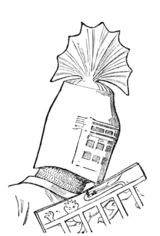penny in the "tuppence" for the coloured or decorated variety. The many instances which can be found of these fan-shaped ornaments upon helmets in a perfectly undecorated form leads me to unhesitatingly assert that they originated not as crests, nor as a vehicle for the display of crests, but as an integral and protective part of the helmet itself. The origin of the crest is due to the decoration of the fan. The derivation of the word "crest," from the Latin crista, a cock's comb, should put the supposition beyond any doubt.
Disregarding crests of later grant or assumption, one can assert with confidence that a large proportion of those—particularly in German armory, where they are so frequent—which we now find blazoned or depicted as wings or plumes, carrying a device, are nothing more than developments of or derivatives from these fan-shaped ornaments.
These fans being (from other reasons) in existence, of course, and very naturally, were painted and decorated, and equally of course such decoration took the form of the particular decoration associated with the owner, namely, the device upon the shield. It seems to me, and for long has so seemed, essentially strange that no specialist authority, writing upon armory, has noticed that these "fans" (as I will call them) are really a part, though possibly only a decorative part, of the helmet itself. There has always in these matters been far too great a tendency on the part of writers to accept conclusions of earlier authorities ready made, and to simply treat these fans as selected and chosen crests. Figs. 610-612 are instances of helmets having these fans. All are



